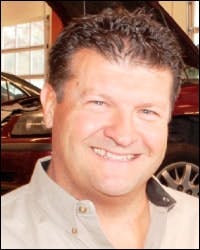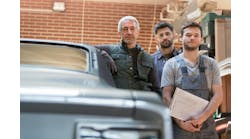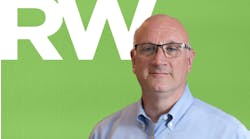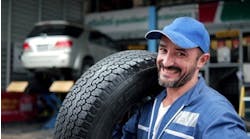Rad Air Complete Car Care started as a two-bay radiator and air conditioner shop nearly 40 years ago and has grown into a thriving, 12-location company. And it’s still on the move.
Knowing how to grow is a difficult task for many shop owners; even Rad Air CEO Andy Fiffick admits he waited 10 years before opening his second store. However, with a dozen locations under his belt and more on the way, Fiffick has become known as “a master of expansion.”
He talked with Ratchet+Wrench about how other shops do the same.
How do you know when you are ready to grow?
I did not want to open my second location until my first location was 100 percent sound, making great money and with a staff in place that was second to none. You want to get that first location to be all it can be. Make sure you are running at capacity and maximizing throughput. I never wanted to have to worry about that business faltering while I was concentrating on a second location.
Doing “well” and being self-sustaining are two totally different things. For example, have you paid the loans off from the first store? Did you postpone buying the equipment you needed? The reason I say that is because at any one time, something catastrophic could affect you. When you look at the businesses that didn’t make it through a transition time, they’re the ones that are over-extended, ill prepared, not staffed well or didn’t have a game plan in place.
To me, I didn’t want to open that second store until I knew that no matter what happens to the second store, the first one will survive. I waited 11 years before I opened my second location.
Can you outline your process for deciding when to expand? What are the factors you consider?
There are three factors that we consider. First and foremost, when to expand is when you have the staff available to do it. It does you no good to find a site if you don’t have the manpower.
Number two, is site selection. It has to be the right demographic and the right area. We are most successful in the neighborhoods where we’re close to where people live and/or work.
And number three is cost. There are a lot of sites that could be available but the cost factor is out of line. We’ve been looking to move into downtown Cleveland for over 15 years. We just finally landed a site that works at the right price. Those three factors play a huge role.
How do you staff your new locations? Do you break up existing staff?
We always try to over-staff all the time. I always have people in the works, so that gives us the availability. We always have good managers in each location followed up by good assistant managers followed up by good staff and followed up with an apprenticeship staff.
If we’re constantly bringing new blood in and they’re working up through the ranks, somewhere along the line you feel comfortable enough that you could pull one here, one there and put a team together. We like to promote from within. We have very few people that come from outside the company and into a management position. Usually it’s people that have been with us for a long time.
I would never consider hiring an all-new staff. We are pretty unique in the way we operate. That takes a mentality and an understanding of why we do that. It takes time to build that culture and it takes a personality that is kind, giving and understanding. That’s not always easy to find.
There is something to be said for assembling that very, very good team. That’s a team where everyone works off each other’s strengths and weaknesses. There’s that little idiosyncrasy where each technician has their own little specialty. You need to get the team together that works and plays well together.
How do you select the right location?
Right now, we have a real estate broker that we deal with. We start by looking at all of the areas we are in, then we look at the areas we are not in, and then we give the broker the parameters.
Those parameters are the desired household income and density level. For example, you can have a great household income but you look at the density and there’s 3,000 people living within the first mile radius of the store. To put it simply, we’re looking for the best possible household income and the highest density place. This could be different for every city, so you have to know your numbers.
To find those parameters, we looked at our history and our numbers. Our average repair order (RO) is $450, and we work on cars that are in the 5- to 12-year-old range. That range and high RO signifies that the customer is employed and has some sort of household income.
You also have to have the ability that you’re convenient to their work, their drive to work, or their home. We have a store that is hidden in plain sight on a section of road that is seven lanes wide. You can’t take your eyes off the road to see our spot for a split second. You drive through there and it’s a white-knuckle area. I think we’ve had a harder time attracting clients there because people are like, “I’m not going down there because the traffic is insane.”
You can have all those factors—the right density and home income—but you also have to have the intangible things, like traffic flow, rivers, bridges. They may not come into the equation in a mathematical way.
When we locate a potential location, I usually spend three or four days at different times driving by, driving through the neighborhood trying to get the feel of it. I also look at what kind of cars are in the driveway. If you see all brand-new BMWs and Mercedes, we know darn well that those cars end up back at the dealership for the first five years of its life. If you’re finding all middle-class vehicles, you’ve got a shot.
Normally, we have our feelers out with our brokers looking at different areas. So we’re always looking. Any time you locate a site, you’ve got a minimum of three to four months before you’re going to get it. That gives you the time to get ready for it.
What factors into determining the cost of expanding?
It’s always cost versus potential. Our history tells us what we can do in that neighborhood based on car count, density and household income. Then we could extrapolate what we can or can’t do.
Probably the biggest mistake anyone could make is overestimating sales and paying more than you should. That’s how businesses fail every day: They’re under capitalized. You need to be so realistic about what the possibilities are. I would say take your best-case number you think it’s going to be, divide that by half and you may be close. If you can survive on half of what you think you’re going to do, then you’re probably going to be OK.
When we look at any new store, we want to have enough money in the bank to pay the rent and the overhead for six months before we ever open the door. I can know my rent is covered, my advertising is covered, my payroll’s covered, my insurance is covered for six months. Now that allows me the time and the ability to survive the startup and get the client base going.
I also build in $30,000 of startup advertising fee in each budget. It’s so important to go into that neighborhood and create the buzz that you’re there.
The number one tip is to make sure you have the money available to do it without sacrificing your initial shop. Number two, I did not open a second store until I had store number one paid off in full. All equipment, land, property. I never wanted to jeopardize store number one.



